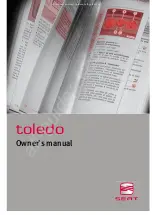
and one-half times as well on the government
course as a tire graded 100.
The relative performance of tires depends upon
the actual conditions of their use, however, and
may depart significantly from the norm due to
variations in driving habits, service practices and
differences in road characteristics and climate
conditions.
Traction grade
&
DANGER Risk of accident due to inade‐
quate traction
The traction grade assigned to this tire is
based on straight-ahead braking traction
tests, and does not include either accelera‐
tion, cornering, hydroplaning or peak traction
characteristics.
#
Always adapt your driving style and
drive at a speed to suit the prevailing
traffic and weather conditions.
*
NOTE Damage to the drivetrain from
wheelspin
#
Avoid wheelspin.
The traction grades – from highest to lowest –
are AA, A, B and C. Those grades represent the
tire's ability to stop on wet pavement as meas‐
ured under controlled conditions on specified
government test surfaces made of asphalt and
concrete.
Temperature grade
&
WARNING Risk of accident from tire
overheating and tire failure
The temperature grade for this tire is estab‐
lished for a tire that is properly inflated and
not overloaded. Excessive speed, underinfla‐
tion, or excessive loading, either separately
or in combination, can cause excessive heat
build-up and possible tire failure.
#
Observe the recommended tire pres‐
sures and regularly check the tire pres‐
sure of all tires including the spare
wheel.
#
Adjust the tire pressure as necessary.
The temperature grades are A (the highest), B
and C. They represent the tire's resistance to the
generation of heat and its ability to dissipate
heat when tested under controlled conditions on
a specified indoor laboratory test wheel. Sus‐
tained high temperatures can cause the material
of the tire to degenerate and reduce tire life. Fur‐
thermore, excessive temperatures can lead to
sudden tire failure. Grade C corresponds to a
level of performance which all passenger car
tires must meet under the requirements of the
US Department of Transportation.
DOT, Tire Identification Number (TIN)
US tire regulations stipulate that every tire man‐
ufacturer or retreader must imprint a TIN in or
on the side wall of each tire produced.
324 Wheels and tires
Summary of Contents for E-class
Page 7: ...5 ...
Page 8: ...6 At a glance Cockpit ...
Page 10: ...Instrument display standard 8 At a glance Cockpit ...
Page 12: ...Instrument display in the Widescreen Cockpit 10 At a glance Warning and indicator lamps ...
Page 14: ...12 At a glance Overhead control panel ...
Page 16: ...14 At a glance Door control panel and seat adjustment ...
Page 18: ...16 At a glance Emergencies and breakdowns ...
Page 444: ...442 ...
Page 445: ...443 ...
Page 446: ...444 ...
















































